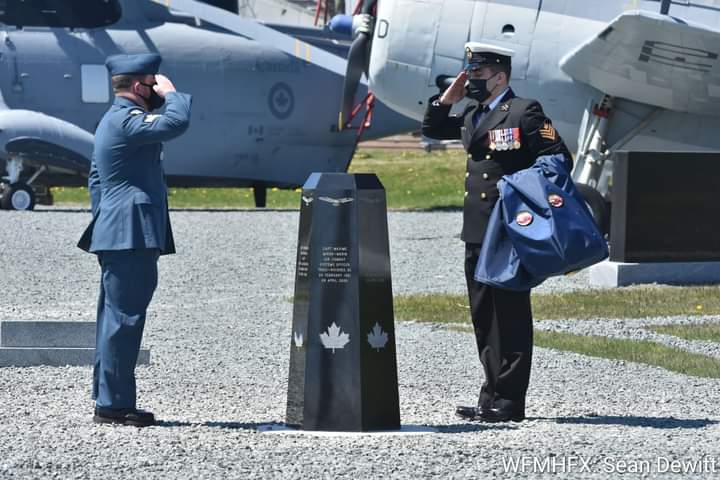**** DND Media Release
Flight Safety Investigation Report for Stalker 22 Accident

The Airworthiness Investigative Authority for the Canadian Armed Forces has concluded its flight safety investigation into the accident that occurred on April 29, 2020 in the Ionian Sea involving a CH-148 Cyclone helicopter that claimed the lives of six Canadian Armed Forces members. The helicopter, known by its call-sign Stalker 22, was operating from Her Majesty’s Canadian Ship Fredericton as part of Standing NATO Maritime Group 2 under Operation REASSURANCE.
Lost in the accident were Master Corporal Matthew Cousins, Sub-Lieutenant Abbigail Cowbrough, Captain Kevin Hagen, Captain Brenden MacDonald, Captain Maxime Miron-Morin, and Sub-Lieutenant Matthew Pyke.

The complete findings of the investigation and recommendations are released today and detailed in the CH148822 Flight Safety Investigation Report.
The investigation concluded that during a complex turning manoeuver at low altitude, when the helicopter was returning to the ship, the aircraft did not respond as the crew would have expected due to a Command Model Attitude Bias Phenomenon. This phenomenon develops under a very specific and narrow set of circumstances where manual inputs to the primarily flight controls override the aircraft’s automation system, referred to as the Flight Director, while it is engaged and set to fly at a fixed airspeed or pitch attitude. The bias that developed in this instance resulted in insufficient aft cyclic controller authority, resulting in a high-energy descent and impact with the water.
A series of other causal factors were highlighted in the report, to include:
- Control inputs when flying with the Flight Director engaged were not verbalized in the cockpit,
- Flying publications contained information that may have been confusing or misleading,
- The Statement of Operating Intent for the CH-148 did not specify the operational requirement to fly the manoeuver involved in the accident,
- Standard operating procedures for this manoeuver were undocumented,
- It was common practice to manually override primary flight controls while the Flight Director was engaged, and
- The mode annunciation may not have sufficiently drawn the pilot’s attention to the fact the Flight Director was engaged during the manoeuver.

Recommendations include the need to modify software in the electronic flight control laws to enhance flight mode annunciation and awareness to the crew, amend CH-148 publications regarding automation strategies, and establish a working group to review the Maritime Helicopter Project Statement of Operating Intent. This review will determine the CH-148 operational requirements to fly complex turning manoeuvers, including the one that led to this accident.
Quotes
“This accident was not the result of one single causal factor, but a combination of several and could have happened to any other crew on any other day. We concluded the Command Model Attitude Bias Phenomenon was an active causal factor, which was unknown to the manufacturer, airworthiness authorities, and aircrew prior to the accident. Over the course of 13 months, we analyzed an extensive quantity of data and worked closely with partners to identify other contributing factors. The Flight Safety Investigation Report delivers a number of recommendations to prevent a similar accident from happening in the future.”
Brigadier-General John Alexander, Director of Flight Safety, Royal Canadian Air Force
“We accept and have been implementing the report’s recommendations. The CH-148 Cyclone continues to make important contributions to Canadian Armed Forces operations at home and around the world, and we remain fully confident in the aircraft’s cutting-edge capabilities and those who fly and maintain them every day. We will never forget the dedication of the six colleagues we lost in this tragedy, and will continue to support their families, friends, shipmates and squadron mates.”
Major-General Eric Kenny, Commander 1 Canadian Air Division, Royal Canadian Air Force
Quick Facts
- Prior to being publicly released, the CH148822 Flight Safety Investigation Report was briefed to all designated next of kin of our fallen Royal Canadian Air Force and Royal Canadian Navy personnel.
- On June 8, 2020, the preliminary From the Investigator report was released and confirmed the investigation was focusing on aircraft systems and human factors.
- On June 16, 2020, an operational pause on the CH-148 Cyclone fleet was lifted. The return to flying operations followed a thorough risk assessment that outlined a number of preventative measures to ensure aircrews understood the conditions that led to the accident and how to avoid or resolve them.
- Since the lifting of the operational pause, the CH-148 Cyclone fleet has flown over 4000 hours on training and operations in Canada and while deployed on Operations ARTEMIS, REASSURANCE and PROJECTION.
- An independent Board of Inquiry (BOI), ordered by the Commander of Canadian Joint Operations Command in May 2020, has also been completed and briefed to family representatives. The purpose of this administrative investigation was to determine facts surrounding the incident, make findings and propose recommendations to prevent recurrence.




